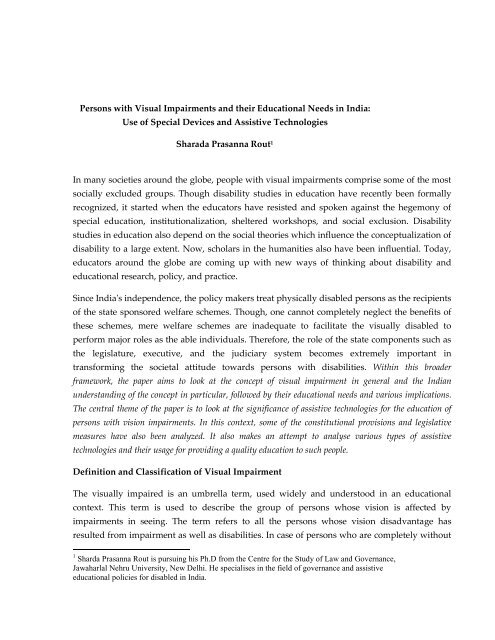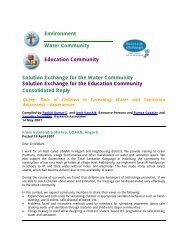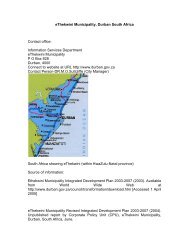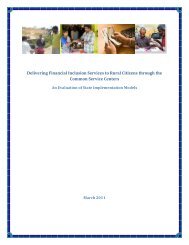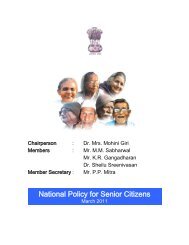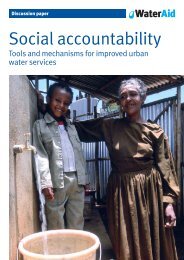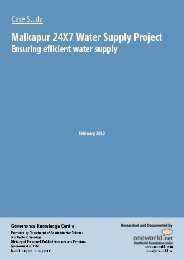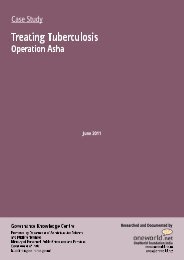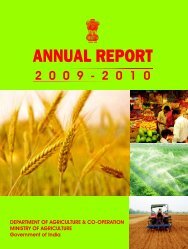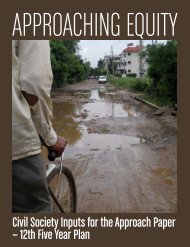Assistive technologies and the education system in India
Assistive technologies and the education system in India
Assistive technologies and the education system in India
You also want an ePaper? Increase the reach of your titles
YUMPU automatically turns print PDFs into web optimized ePapers that Google loves.
Persons with Visual Impairments <strong>and</strong> <strong>the</strong>ir Educational Needs <strong>in</strong> <strong>India</strong>:Use of Special Devices <strong>and</strong> <strong>Assistive</strong> TechnologiesSharada Prasanna Rout 1In many societies around <strong>the</strong> globe, people with visual impairments comprise some of <strong>the</strong> mostsocially excluded groups. Though disability studies <strong>in</strong> <strong>education</strong> have recently been formallyrecognized, it started when <strong>the</strong> educators have resisted <strong>and</strong> spoken aga<strong>in</strong>st <strong>the</strong> hegemony ofspecial <strong>education</strong>, <strong>in</strong>stitutionalization, sheltered workshops, <strong>and</strong> social exclusion. Disabilitystudies <strong>in</strong> <strong>education</strong> also depend on <strong>the</strong> social <strong>the</strong>ories which <strong>in</strong>fluence <strong>the</strong> conceptualization ofdisability to a large extent. Now, scholars <strong>in</strong> <strong>the</strong> humanities also have been <strong>in</strong>fluential. Today,educators around <strong>the</strong> globe are com<strong>in</strong>g up with new ways of th<strong>in</strong>k<strong>in</strong>g about disability <strong>and</strong><strong>education</strong>al research, policy, <strong>and</strong> practice.S<strong>in</strong>ce <strong>India</strong>'s <strong>in</strong>dependence, <strong>the</strong> policy makers treat physically disabled persons as <strong>the</strong> recipientsof <strong>the</strong> state sponsored welfare schemes. Though, one cannot completely neglect <strong>the</strong> benefits of<strong>the</strong>se schemes, mere welfare schemes are <strong>in</strong>adequate to facilitate <strong>the</strong> visually disabled toperform major roles as <strong>the</strong> able <strong>in</strong>dividuals. Therefore, <strong>the</strong> role of <strong>the</strong> state components such as<strong>the</strong> legislature, executive, <strong>and</strong> <strong>the</strong> judiciary <strong>system</strong> becomes extremely important <strong>in</strong>transform<strong>in</strong>g <strong>the</strong> societal attitude towards persons with disabilities. With<strong>in</strong> this broaderframework, <strong>the</strong> paper aims to look at <strong>the</strong> concept of visual impairment <strong>in</strong> general <strong>and</strong> <strong>the</strong> <strong>India</strong>nunderst<strong>and</strong><strong>in</strong>g of <strong>the</strong> concept <strong>in</strong> particular, followed by <strong>the</strong>ir <strong>education</strong>al needs <strong>and</strong> various implications.The central <strong>the</strong>me of <strong>the</strong> paper is to look at <strong>the</strong> significance of assistive <strong>technologies</strong> for <strong>the</strong> <strong>education</strong> ofpersons with vision impairments. In this context, some of <strong>the</strong> constitutional provisions <strong>and</strong> legislativemeasures have also been analyzed. It also makes an attempt to analyse various types of assistive<strong>technologies</strong> <strong>and</strong> <strong>the</strong>ir usage for provid<strong>in</strong>g a quality <strong>education</strong> to such people.Def<strong>in</strong>ition <strong>and</strong> Classification of Visual ImpairmentThe visually impaired is an umbrella term, used widely <strong>and</strong> understood <strong>in</strong> an <strong>education</strong>alcontext. This term is used to describe <strong>the</strong> group of persons whose vision is affected byimpairments <strong>in</strong> see<strong>in</strong>g. The term refers to all <strong>the</strong> persons whose vision disadvantage hasresulted from impairment as well as disabilities. In case of persons who are completely without1 Sharda Prasanna Rout is pursu<strong>in</strong>g his Ph.D from <strong>the</strong> Centre for <strong>the</strong> Study of Law <strong>and</strong> Governance,Jawaharlal Nehru University, New Delhi. He specialises <strong>in</strong> <strong>the</strong> field of governance <strong>and</strong> assistive<strong>education</strong>al policies for disabled <strong>in</strong> <strong>India</strong>.
vision or who have light perception only, it is desirable to use <strong>the</strong> term ‚bl<strong>in</strong>d‛. In all o<strong>the</strong>rcases of visual defects <strong>the</strong> term ‚visually impaired‛ should preferably be used. For <strong>the</strong> personswhose visual acuity falls between 6/ 18 <strong>and</strong> 6/60 <strong>in</strong> <strong>the</strong> better eye after <strong>the</strong> best possiblecorrection, <strong>the</strong> term ‚low vision‛ should be used. In context of vision defects, a variety of termsviz. totally bl<strong>in</strong>d, stone bl<strong>in</strong>d, bl<strong>in</strong>d, partially bl<strong>in</strong>d, legally bl<strong>in</strong>d, economically bl<strong>in</strong>d, visuallylimited, low vision, partially sighted, visually h<strong>and</strong>icapped, visually impaired etc. are be<strong>in</strong>gused {RamaKrishna T. 2009, Armstrong 2009,http://www.pls.org.uk/ngen_public/default.asp?id=60 }.Underst<strong>and</strong><strong>in</strong>g of visual impairment <strong>in</strong> <strong>India</strong>The most common def<strong>in</strong>ition <strong>and</strong> classification of disability used by <strong>the</strong> Government of <strong>India</strong>for all purposes was determ<strong>in</strong>ed with <strong>the</strong> enactment of <strong>the</strong> Persons with Disabilities (EqualOpportunities, Protection of Rights <strong>and</strong> Full Participation) Act, 1995 (section 2). Disability hasbeen classified <strong>in</strong>to seven classes on <strong>the</strong> basis of medical def<strong>in</strong>ition. These classes <strong>in</strong>clude peoplewith bl<strong>in</strong>dness, low-vision, leprosy (cured), hear<strong>in</strong>g impairment, locomotor disability, mentalretardation <strong>and</strong> mental illness. Out of <strong>the</strong> coverage of each of <strong>the</strong> aforesaid seven groups, <strong>the</strong>Persons with Disabilities (Equal Opportunities, Protection of Rights <strong>and</strong> Full Participation) Act,1995 has given <strong>the</strong> follow<strong>in</strong>g respective def<strong>in</strong>itions to bl<strong>in</strong>dness <strong>and</strong> low-vision:Bl<strong>in</strong>dness refers to a condition where a person suffers from any of <strong>the</strong> follow<strong>in</strong>gconditions namely:‣ Total absence of sight; or‣ Visual acuity not exceed<strong>in</strong>g 6/60 or 20/200 (Snellen test) <strong>in</strong> <strong>the</strong> better eye withcorrect<strong>in</strong>g lenses; or‣ Limitation of <strong>the</strong> field of vision subtend<strong>in</strong>g an angle of 200 or worse.Person with low–vision means a person with impairment of visual function<strong>in</strong>g, evenafter treatment or st<strong>and</strong>ard refractive correction but who uses, or is potentiallycapable of us<strong>in</strong>g, vision for <strong>the</strong> plann<strong>in</strong>g or execution of a task with appropriateassistive device.Thus, bl<strong>in</strong>dness <strong>in</strong> <strong>India</strong> has been classified broadly under two categories: i.e., totalbl<strong>in</strong>dness <strong>and</strong> low-vision. If we analyze <strong>the</strong> above mentioned def<strong>in</strong>itions of <strong>the</strong> concept‘visual impairment’ we can clearly f<strong>in</strong>d some practical problems. Though low vision <strong>and</strong>no-vision have been def<strong>in</strong>ed separately, <strong>the</strong>y broadly come under <strong>the</strong> category ofvisually impaired. A totally visually impaired <strong>in</strong>dividual is quite different from a personhav<strong>in</strong>g low vision.
Educational Needs <strong>and</strong> ImplementationAs per <strong>the</strong> Constitution of <strong>India</strong>, <strong>education</strong> is as one of our fundamental rights. In ourcountry, we earlier had <strong>the</strong> concept of special <strong>education</strong> for <strong>the</strong> disabled sector <strong>in</strong>clud<strong>in</strong>gstudents with visual impairments. However <strong>in</strong> <strong>the</strong> mid 1970s <strong>the</strong> <strong>in</strong>tegrated <strong>system</strong> of<strong>education</strong> has come <strong>in</strong>to existence. Besides this, many non-governmental organizationswith <strong>the</strong> help of <strong>the</strong> state adm<strong>in</strong>istration are impart<strong>in</strong>g traditional vocational <strong>education</strong>to <strong>the</strong> disabled. Now due to technology friendl<strong>in</strong>ess, <strong>the</strong> focus is be<strong>in</strong>g given on distancemode as <strong>the</strong> means to educate <strong>the</strong>se sections of people by provid<strong>in</strong>g <strong>the</strong>m all sort ofaccessibility. The government has formulated a few policies <strong>and</strong> legislations regard<strong>in</strong>g<strong>the</strong> <strong>education</strong> of people with disabilities.In an ideal <strong>system</strong> of <strong>in</strong>clusive <strong>education</strong>, <strong>the</strong> general <strong>education</strong> itself should make <strong>the</strong><strong>education</strong> of disabled children as its <strong>in</strong>tegral part. This implies that <strong>the</strong> generalclassroom teachers should be equipped with skills to address <strong>the</strong> <strong>education</strong>al needs ofchildren with disabilities with m<strong>in</strong>imum or no assistance of specialist resource teachers.This calls for streng<strong>the</strong>n<strong>in</strong>g <strong>the</strong> pre-service general teacher preparation programme with<strong>the</strong> <strong>in</strong>clusion of adequate component of <strong>the</strong> <strong>education</strong> of disabled children <strong>in</strong> <strong>the</strong>curriculum. Therefore, <strong>in</strong>clusive <strong>education</strong> means creat<strong>in</strong>g effective classrooms where<strong>the</strong> <strong>education</strong>al needs of all children are addressed irrespective of ability or disability.Most people feel that educat<strong>in</strong>g a child with disability <strong>in</strong> general school is <strong>in</strong>clusion butit can be treated as total <strong>in</strong>clusion only when <strong>the</strong> general classroom teachers take most of<strong>the</strong> responsibilities for <strong>the</strong> <strong>education</strong> of <strong>the</strong>se children. If <strong>the</strong> disabled child's needs aretaken care of, only by a specialist teacher <strong>in</strong> <strong>the</strong> general school, it is not total <strong>in</strong>clusion{Mukhopadhyay, S. <strong>and</strong> Mani, M.N.G. 1999, Ramakrishna T. 2009}. Access <strong>in</strong>volvesmuch more than provid<strong>in</strong>g ramps. Access is also <strong>the</strong> key element of <strong>in</strong>clusion, which<strong>in</strong>volves much more than placement <strong>in</strong> a particular sett<strong>in</strong>g. The relationship of access<strong>and</strong> <strong>in</strong>clusion may not be obvious to <strong>in</strong>dividuals who are not familiar with <strong>the</strong><strong>education</strong>al <strong>and</strong> social impact of a vision loss. Plac<strong>in</strong>g a student with a visualimpairment <strong>in</strong> a regular classroom does not necessarily provide access <strong>and</strong> <strong>the</strong> student isnot necessarily taken <strong>in</strong>to consideration. A student with a visual impairment, who doesnot have access to social <strong>and</strong> physical <strong>in</strong>formation because of visual impairment, is not<strong>in</strong>cluded, regardless of <strong>the</strong> physical sett<strong>in</strong>g. Students with visual impairments will notbe <strong>in</strong>cluded unless <strong>the</strong>ir unique <strong>education</strong>al needs for access are addressed by speciallytra<strong>in</strong>ed personnel <strong>in</strong> appropriate environments <strong>and</strong> unless <strong>the</strong>se students are providedwith equal access to core <strong>and</strong> specialized curricula through appropriate specializedbooks, materials <strong>and</strong> equipments {Petty, R.E. 2012}.
It is important to remember that <strong>education</strong>al goals for students with visual impairmentsare essentially <strong>the</strong> same as those for all students. The goals are: effective communication,social competence, employability, <strong>and</strong> personal <strong>in</strong>dependence. In order to accomplish<strong>the</strong>se goals, however, students with visual impairments require specific <strong>in</strong>terventions<strong>and</strong> modifications of <strong>the</strong>ir <strong>education</strong>al programs. An appropriate assessment of <strong>the</strong>seunique <strong>education</strong>al needs <strong>in</strong> all areas related to <strong>the</strong> disability <strong>and</strong> <strong>in</strong>struction adapted tomeet <strong>the</strong>se needs is essential to ensure suitable <strong>education</strong>al programm<strong>in</strong>g {RamakrishnaT. 2009}.Legislative measuresIn order to provide quality <strong>education</strong> to <strong>the</strong> disabled, <strong>the</strong> Government of <strong>India</strong> hasformulated <strong>and</strong> enacted a number of policies <strong>and</strong> programmes. The Government of <strong>India</strong>had numerous objectives to uplift <strong>the</strong> condition of <strong>the</strong> disabled people, which arereflected <strong>in</strong> different five year plans. In <strong>the</strong> last decade, academicians, social activists,<strong>and</strong> policy makers have realized <strong>the</strong> need for <strong>in</strong>tegrat<strong>in</strong>g disabled persons <strong>in</strong>to <strong>the</strong>ma<strong>in</strong>stream society. Due to <strong>the</strong>ir coord<strong>in</strong>ated efforts, <strong>the</strong> "Persons with Disabilities(Equal Opportunities, Protection of Rights & Full Participation) Act" was <strong>in</strong>troduced <strong>in</strong>Parliament <strong>in</strong> 1995 <strong>and</strong> it was a significant l<strong>and</strong>mark <strong>in</strong> empower<strong>in</strong>g persons withdisabilities, <strong>in</strong>clud<strong>in</strong>g <strong>the</strong> visually disabled ones. This act for <strong>the</strong> first time treated <strong>the</strong>rights of persons with disabilities as <strong>the</strong> Human rights. The act establishes responsibilityon <strong>the</strong> society to make relevant adjustments, so as to help <strong>the</strong> visually disabled toovercome various practical, psychological <strong>and</strong> social hurdles created by <strong>the</strong>ir disability.The act places disabled people at par with o<strong>the</strong>r citizens of <strong>India</strong> with respect to<strong>education</strong>, vocational tra<strong>in</strong><strong>in</strong>g <strong>and</strong> employment. Thus, for a change, <strong>the</strong> state treated <strong>the</strong>"persons with disabilities" as active participants <strong>in</strong> various social activities ra<strong>the</strong>r than<strong>the</strong> recipients of mere welfare schemes. Due to <strong>the</strong>se developments, <strong>the</strong> disabled areviewed as <strong>in</strong>dividuals with a wide range of abilities <strong>and</strong> each one of <strong>the</strong>m will<strong>in</strong>g <strong>and</strong>capable to utilize his/her potential <strong>and</strong> talents.National Policy for Persons with Disabilities-(2006)The constitution of <strong>India</strong> ensures equality, freedom, justice <strong>and</strong> dignity of all <strong>in</strong>dividualsimplicitly <strong>and</strong> m<strong>and</strong>ates an <strong>in</strong>clusive society for all <strong>in</strong>clud<strong>in</strong>g persons with disabilities.The national policy for persons with disabilities recognizes that persons with disabilitiesare valuable human resources for <strong>the</strong> country <strong>and</strong> seeks to create an environment thatprovides <strong>the</strong>m equal opportunities, protection of <strong>the</strong>ir rights <strong>and</strong> full participation <strong>in</strong> <strong>the</strong>society. Some of <strong>the</strong> focused areas <strong>in</strong> this policy are:
Development of assistive devicesEducation for persons with disabilitiesAssurance of barrier-free environmentPromotion of researchSome of <strong>the</strong> measures discussed <strong>in</strong> <strong>the</strong> policy statement for <strong>the</strong> promotion of <strong>education</strong>of <strong>the</strong> persons with various disabilities are reproduced below:-1) Medium <strong>and</strong> method of teach<strong>in</strong>g will be suitably adapted to <strong>the</strong> requirements ofmost disability conditions.2) Technical/ supplementary/ specialized <strong>system</strong> of teach<strong>in</strong>g/learn<strong>in</strong>g will be madeavailable with<strong>in</strong> <strong>the</strong> school or at a common center easily accessible to a cluster ofschools.3) Teach<strong>in</strong>g/learn<strong>in</strong>g tools <strong>and</strong> aids such as <strong>education</strong>al toys, Braille/talk<strong>in</strong>g books,appropriate software etc. will be made available. Incentives will be given to exp<strong>and</strong>facilities for sett<strong>in</strong>g up of general libraries, e-libraries, Braille-libraries <strong>and</strong> talk<strong>in</strong>gbooks libraries, resource rooms etc.4) Sign language, Alternative <strong>and</strong> Augmentative Communications (AAC) <strong>and</strong> o<strong>the</strong>rmodes as a viable medium <strong>in</strong> <strong>in</strong>ter personal communication will be recognized,st<strong>and</strong>ardized <strong>and</strong> popularized.In <strong>the</strong> era of knowledge society, computers play very important role. Efforts will bemade so that every child with disability gets suitably exposed to <strong>the</strong> use of computers.(Source:-National Policy for Persons with Disabilities, Government of <strong>India</strong>-2006).UN Convention on <strong>the</strong> Rights of Persons with DisabilitiesUnited Nations organization has come up with comprehensive <strong>and</strong> <strong>in</strong>tegral <strong>in</strong>ternationalconvention to promote <strong>and</strong> protect <strong>the</strong> rights <strong>and</strong> dignity of persons with disabilities <strong>in</strong>December 2006. By recall<strong>in</strong>g <strong>the</strong> pr<strong>in</strong>ciples proclaimed <strong>in</strong> <strong>the</strong> United Nations charterwhich recognizes <strong>the</strong> <strong>in</strong>herent dignity <strong>and</strong> worth <strong>and</strong> <strong>the</strong> equal <strong>and</strong> <strong>in</strong>alienable rights ofall members of <strong>the</strong> human family as <strong>the</strong> foundation of freedom, justice, peace <strong>in</strong> <strong>the</strong>world, this convention on <strong>the</strong> rights of persons with disabilities recognizes that disabilityis an evolv<strong>in</strong>g concept <strong>and</strong> it results from <strong>the</strong> <strong>in</strong>teraction between persons withimpairments <strong>and</strong> attitud<strong>in</strong>al <strong>and</strong> environmental barriers that h<strong>in</strong>ders <strong>the</strong>ir full <strong>and</strong>effective participation <strong>in</strong> society on an equal basis with o<strong>the</strong>rs. It also recognizes <strong>the</strong>
importance of accessibility to physical, social, economic <strong>and</strong> cultural environments, tohealth <strong>and</strong> <strong>education</strong> <strong>and</strong> to <strong>in</strong>formation <strong>and</strong> communication, <strong>in</strong> enabl<strong>in</strong>g persons withdisabilities to fully enjoy all human rights <strong>and</strong> fundamental freedoms.<strong>India</strong> had adapted <strong>the</strong> same UN convention on <strong>the</strong> rights of persons with disabilities <strong>in</strong>October 2007. The issue of <strong>education</strong> has been dealt separately <strong>in</strong> article 24 of <strong>the</strong>convention <strong>in</strong> detail. Some of <strong>the</strong> features are as follows:1. In realiz<strong>in</strong>g this right, States Parties shall ensure that:(a) Persons with disabilities are not excluded from <strong>the</strong> general <strong>education</strong> <strong>system</strong> on <strong>the</strong>basis of disability, <strong>and</strong> that children with disabilities are not excluded from free <strong>and</strong>compulsory primary <strong>education</strong>, or from secondary <strong>education</strong>, on <strong>the</strong> basis ofdisability;(b) Persons with disabilities can access an <strong>in</strong>clusive, quality <strong>and</strong> free primary <strong>education</strong><strong>and</strong> secondary <strong>education</strong> on an equal basis with o<strong>the</strong>rs <strong>in</strong> <strong>the</strong> communities <strong>in</strong> which<strong>the</strong>y live;(c) Reasonable accommodation of <strong>the</strong> <strong>in</strong>dividual’s requirements is provided;(d) Persons with disabilities receive <strong>the</strong> support required, with<strong>in</strong> <strong>the</strong> general <strong>education</strong><strong>system</strong>, to facilitate <strong>the</strong>ir effective <strong>education</strong>;(e) Effective <strong>in</strong>dividualized support measures are provided <strong>in</strong> environments thatmaximize academic <strong>and</strong> social development, consistent with <strong>the</strong> goal of full<strong>in</strong>clusion.2. States Parties shall ensure that persons with disabilities are able to access generaltertiary <strong>education</strong>, vocational tra<strong>in</strong><strong>in</strong>g, adult <strong>education</strong> <strong>and</strong> lifelong learn<strong>in</strong>g withoutdiscrim<strong>in</strong>ation <strong>and</strong> on an equal basis with o<strong>the</strong>rs. To this end, States Parties shall ensurethat reasonable accommodation is provided to persons with disabilities.(Source: UNconvention document on <strong>the</strong> rights of persons with disabilities)Despite all <strong>the</strong>se attempts of <strong>the</strong> government to develop <strong>the</strong> overall condition of <strong>the</strong>disabled persons <strong>in</strong> general <strong>and</strong> <strong>the</strong>ir <strong>education</strong>al level <strong>in</strong> particular, <strong>the</strong>ir achievement <strong>in</strong><strong>education</strong>al level is not satisfactory. A study conducted by <strong>the</strong> National Centre forPromotion of Employment for Disabled People (NCPEDP) available athttp://www.ncpedp.org/eductn/ed-resrch.htm disclosed shock<strong>in</strong>g facts of discrim<strong>in</strong>ationaga<strong>in</strong>st those with disabilities. A survey of 89 schools across <strong>the</strong> country found that amere 0.5 percent of <strong>the</strong> total number of students were those with disabilities, though <strong>the</strong>
Persons with Disabilities Act recommended a reservation of three percent seats <strong>in</strong><strong>in</strong>stitutions funded by <strong>the</strong> government. Eighteen of <strong>the</strong> schools surveyed acknowledgedthat <strong>the</strong>y did not admit students with disabilities. Twenty percent of <strong>the</strong> schools polledwere not aware of <strong>the</strong> 1995 Disability Act at all. While girls comprised 41.6 percent of <strong>the</strong>total student population, among children with disabilities, <strong>the</strong> percentage of girls wasonly 33. While Education comes under <strong>the</strong> M<strong>in</strong>istry of Human Resource Development <strong>in</strong><strong>India</strong>, <strong>education</strong> for those with disabilities comes under <strong>the</strong> M<strong>in</strong>istry of Social Justice <strong>and</strong>Empowerment. Education of People with Disabilities is still considered an act of charity.The disabled persons do not need sympathy. But <strong>the</strong> least <strong>the</strong>y can ask for is sensitivity.Education for <strong>the</strong>m has been a struggle for sure. Until recently, disabled people were notgiven any special attention <strong>in</strong> higher <strong>education</strong>. Till today most of <strong>the</strong> <strong>education</strong>al<strong>in</strong>stitutions are not even made physically accessible. In addition to that <strong>the</strong> studycontents, read<strong>in</strong>g materials, use of assistive technology, <strong>and</strong> <strong>in</strong>dividual need basedsupport is lack<strong>in</strong>g.A study from NCPEDP 2004 available at http://www.ncpedp.org/eductn/ed-resrch.htmshows that only 0.1% (1635) of disabled persons has been enrolled <strong>in</strong> higher <strong>education</strong>al<strong>in</strong>stitutions. In many parts of <strong>the</strong> world <strong>in</strong>clud<strong>in</strong>g <strong>India</strong>, this is still <strong>the</strong> case where<strong>in</strong>stitutions of higher <strong>education</strong> purport to provide equal access <strong>and</strong> reasonableaccommodations, disabled students still face discrim<strong>in</strong>atory policies <strong>and</strong> practices. Inaddition, too little is available about <strong>in</strong>clusive pedagogy <strong>and</strong> policy <strong>in</strong> higher <strong>education</strong>.People with disabilities are precluded from access<strong>in</strong>g or benefit<strong>in</strong>g from ma<strong>in</strong>stream<strong>education</strong>al, vocational tra<strong>in</strong><strong>in</strong>g, employment <strong>and</strong> self-employment <strong>and</strong> <strong>in</strong>comegeneration programmes on account of physical, communication, transportation <strong>and</strong>attitud<strong>in</strong>al barriers. Many of <strong>the</strong> <strong>education</strong>al <strong>in</strong>stitutions are situated <strong>in</strong> <strong>the</strong> urban areas.The illiterate rural masses do not have access to <strong>the</strong>m. The adm<strong>in</strong>istration has failed tocreate awareness among <strong>the</strong> rural people to send <strong>the</strong>ir disabled family members to<strong>education</strong>al <strong>in</strong>stitutions. At <strong>the</strong> same time, most of <strong>the</strong> <strong>in</strong>stitutions to a large extent lack<strong>the</strong> necessary <strong>in</strong>frastructural development, assistive technological support <strong>and</strong> moreimportantly well tra<strong>in</strong>ed teachers. Though society is mov<strong>in</strong>g towards <strong>the</strong> age of<strong>in</strong>formation technology, <strong>in</strong> <strong>India</strong> we do not have sufficient <strong>in</strong>stitutions to br<strong>in</strong>g <strong>the</strong>disabled population to <strong>the</strong> ma<strong>in</strong>stream for compet<strong>in</strong>g with <strong>the</strong>ir counterparts.Use of assistive <strong>technologies</strong>In all <strong>education</strong>al <strong>in</strong>stitutions <strong>in</strong>clud<strong>in</strong>g special <strong>in</strong>stitutions generally, students withspecial needs come with a number of questions. For example, what sort of technological
tools can help <strong>the</strong>m <strong>in</strong> gett<strong>in</strong>g <strong>education</strong> like <strong>the</strong>ir counter parts? Such questions varyfrom person to person depend<strong>in</strong>g upon his/her needs. Hence, it becomes necessary on<strong>the</strong> part of teachers <strong>and</strong> manufacturers to know <strong>the</strong> specific needs of <strong>the</strong>se people <strong>and</strong><strong>the</strong> concepts like assistive technology, universal design <strong>and</strong> accessibility. In this section,an attempt has been made to discuss <strong>the</strong> above mentioned concepts with particularreference to <strong>the</strong> use of assistive <strong>technologies</strong> <strong>and</strong> various methods <strong>and</strong> techniques toadapt <strong>the</strong>m <strong>in</strong> teach<strong>in</strong>g-learn<strong>in</strong>g process. Some assistive <strong>technologies</strong> <strong>and</strong> <strong>the</strong>ir specificuse for students with vision impairments have also been discussed. People withdisabilities or / <strong>and</strong> special needs accord<strong>in</strong>g to <strong>the</strong>ir own requirements need somestructural changes or some extra tools to be added to <strong>the</strong> conventional or traditionaltechnological tools with <strong>the</strong> ma<strong>in</strong> devices for better accessibility. This k<strong>in</strong>d of technologyassists such people to get <strong>the</strong>ir work done. Any device that is used to enhance a person’swork<strong>in</strong>g ability is called a special device or assistive technology. In o<strong>the</strong>r words,assistive technology means alternative or adaptive specialized hardware <strong>and</strong> software,<strong>in</strong>clud<strong>in</strong>g <strong>in</strong>put <strong>and</strong> output devices designed for users with various disabilities{Ramakrishna T. 2009, Petty, R.E. 2012 ) def<strong>in</strong>es assistive technology as ‘Software orhardware that has been specifically designed to assist people with disabilities <strong>in</strong> carry<strong>in</strong>gout daily activities’. These <strong>technologies</strong> help <strong>the</strong> students with learn<strong>in</strong>g <strong>and</strong> physicaldisabilities to actively participate <strong>in</strong> <strong>in</strong>clusive teach<strong>in</strong>g <strong>and</strong> learn<strong>in</strong>g tasks such aswrit<strong>in</strong>g, read<strong>in</strong>g <strong>and</strong> for do<strong>in</strong>g ma<strong>the</strong>matics.To a large extent, assistive <strong>technologies</strong> are found useful <strong>in</strong> creat<strong>in</strong>g new abilities forchildren <strong>and</strong> adults with disabilities <strong>in</strong>clud<strong>in</strong>g sensory, cognitive, learn<strong>in</strong>g <strong>and</strong> physicaldisabilities. This allows <strong>the</strong>se students to <strong>in</strong>dependently complete <strong>the</strong>ir assignments,exam<strong>in</strong>ations <strong>and</strong> o<strong>the</strong>r academic activities. Some examples of assistive <strong>technologies</strong> are:touch control devices, alternative keyboards <strong>and</strong> mouse, speech-to-text word recognitiontools, Word prediction programs, word processors, grammar checkers, scanners,compact disc record<strong>in</strong>g (CD-R <strong>and</strong> CD-RW) drives <strong>and</strong> spell checkers { Petty,2012 }.New <strong>in</strong>novations <strong>and</strong> growth <strong>in</strong> technology is mak<strong>in</strong>g it less <strong>and</strong> less excusable to ignore<strong>the</strong> needs of those who are disabled. Researchers are develop<strong>in</strong>g sophisticated hardware<strong>and</strong> software which help even <strong>the</strong> most severely h<strong>and</strong>icapped <strong>in</strong>dividuals to do <strong>the</strong>irwork successfully <strong>in</strong> <strong>the</strong> ma<strong>in</strong>stream society. The dem<strong>and</strong> for assistive <strong>technologies</strong> is<strong>in</strong>creas<strong>in</strong>g significantly, because now more disabled students are study<strong>in</strong>g <strong>in</strong> normal<strong>education</strong>al sett<strong>in</strong>gs. <strong>Assistive</strong> <strong>technologies</strong> are highly essential for help<strong>in</strong>g students withvarious disabilities to succeed <strong>in</strong> <strong>the</strong>ir studies. These also can enable disabled students tosocially <strong>in</strong>teract with <strong>the</strong>ir non-disabled peers. The similarity between assistive <strong>and</strong>conventional <strong>technologies</strong> revolves round <strong>the</strong> common aspects. In this context, all
activities <strong>in</strong>volve three th<strong>in</strong>gs: <strong>in</strong>put, process<strong>in</strong>g <strong>and</strong> output. Input refers to how onegives <strong>in</strong>formation to a product. Process<strong>in</strong>g is related to <strong>the</strong> electronics that operate on orprocess, accord<strong>in</strong>g to <strong>the</strong> <strong>in</strong>formation one provides. Output means what <strong>the</strong> device does<strong>and</strong> produces with <strong>the</strong> <strong>in</strong>formation provided. The ways <strong>in</strong> which assistive <strong>technologies</strong>are different from conventional <strong>technologies</strong> <strong>in</strong>volve <strong>the</strong>se same three aspects.Individuals with disabilities who use <strong>the</strong>se <strong>technologies</strong> usually select a comb<strong>in</strong>ation ofconventional <strong>and</strong> assistive <strong>technologies</strong>. They rely on <strong>the</strong> conventional ones especiallywhen universal access features are part of <strong>the</strong> product's design. The dist<strong>in</strong>ction betweenassistive <strong>and</strong> conventional <strong>technologies</strong> is becom<strong>in</strong>g less clear because now <strong>the</strong> conceptof universal design is be<strong>in</strong>g <strong>in</strong>corporated <strong>in</strong>to conventional technology. Both assistive<strong>and</strong> conventional fields are broaden<strong>in</strong>g <strong>and</strong> converg<strong>in</strong>g. What is a necessity for some is aconvenience for all. For example, touch screens can be used as alternatives to <strong>the</strong> mousefor people with disabilities. But at <strong>the</strong> same time, <strong>the</strong>se are <strong>the</strong> convenience for o<strong>the</strong>rswhich are generally used <strong>in</strong> ATM mach<strong>in</strong>es <strong>and</strong> at airports. Similarly, voice recognition<strong>system</strong> which allows controll<strong>in</strong>g a computer through verbal comm<strong>and</strong>s can be used bypeople who cannot use a keyboard to provide <strong>in</strong>put. Today, as <strong>the</strong> dem<strong>and</strong> from <strong>the</strong>community of assistive technology users is <strong>in</strong>creas<strong>in</strong>g for universal access,manufacturers have been respond<strong>in</strong>g accord<strong>in</strong>gly. The assistive <strong>and</strong> conventional<strong>technologies</strong> are blend<strong>in</strong>g <strong>and</strong> a new generation of products with easy accessibilityfeatures are emerg<strong>in</strong>g {Armstrong 2009}.Special devices <strong>and</strong> TechnologiesIt is very difficult to classify or label <strong>the</strong> vary<strong>in</strong>g degrees of visual acuity. Most of <strong>the</strong>students with visual impairments need some type of <strong>technologies</strong> for effective learn<strong>in</strong>gwhile pursu<strong>in</strong>g <strong>the</strong>ir studies. The students who are visually impaired but have someuseful vision mostly rely on large-pr<strong>in</strong>t materials, specialized magnification lenses or on<strong>the</strong> electronic enlargement <strong>technologies</strong> for better accessibility. The people with novision, who traditionally had to depend on tape record<strong>in</strong>gs or on Braille pr<strong>in</strong>t, now havemany options of o<strong>the</strong>r devices <strong>and</strong> <strong>technologies</strong> which make <strong>the</strong>m <strong>in</strong>dependent forexample, descriptive video services. This technology provides a detailed verbaldescription of visual elements. These services are useful <strong>in</strong> help<strong>in</strong>g bl<strong>in</strong>d or low visionstudents to use <strong>education</strong>al video programs efficiently. Ano<strong>the</strong>r significant development<strong>in</strong> <strong>the</strong> field of computer technology is <strong>the</strong> <strong>in</strong>novation of syn<strong>the</strong>tic <strong>and</strong> digital speechsyn<strong>the</strong>sizers. These are <strong>the</strong> output <strong>technologies</strong> which assist <strong>the</strong> students withcommunication disorders <strong>and</strong> visual impairments. These text-to-speech applications arealso known as screen readers. With <strong>the</strong> use of <strong>the</strong>se screen readers, visually impairedstudents can read <strong>the</strong> text found on <strong>the</strong> screen aloud. The screen read<strong>in</strong>g <strong>technologies</strong>
also facilitate to read <strong>the</strong> text repeatedly <strong>and</strong> <strong>in</strong> review<strong>in</strong>g or edit<strong>in</strong>g <strong>the</strong> written text.Thus <strong>the</strong>se <strong>technologies</strong> provide an equal platform <strong>and</strong> opportunities to visuallyimpaired students to participate efficiently like <strong>the</strong>ir peer groups <strong>in</strong> all academicactivities {Petty, R.E. 2012}.Ano<strong>the</strong>r useful computer based technology <strong>in</strong> this regard is optical character recognition.It helps <strong>in</strong> scann<strong>in</strong>g <strong>and</strong> read<strong>in</strong>g <strong>the</strong> text aloud. Students with visual impairments canhave access to all types of pr<strong>in</strong>t materials by <strong>the</strong> use of this scann<strong>in</strong>g technology. Because<strong>the</strong>y can scan <strong>the</strong> materials <strong>and</strong> read <strong>the</strong> text with <strong>the</strong> help of screen read<strong>in</strong>g <strong>technologies</strong><strong>in</strong>dividually, now this software is available with most computers <strong>and</strong> scanners. The onlydrawback of this technology is that, it cannot read h<strong>and</strong>written materials accurately. At<strong>the</strong> same time, advances <strong>in</strong> computer <strong>technologies</strong> have made Braille more useful. Anumber of software applications have been developed which comb<strong>in</strong>e Braille withcomputer technology. For example, <strong>in</strong> Braille note takers <strong>the</strong>re is facility to store Braillecharacters <strong>and</strong> read text aloud. These <strong>technologies</strong> have been found useful to assiststudents with visual impairments <strong>in</strong> <strong>the</strong>ir studies. Though Braille displays have alreadybeen developed those <strong>technologies</strong> are still not widely used because of high cost <strong>and</strong> lackof awareness among <strong>the</strong> users.Computer screen magnification: In most of <strong>the</strong> computers available today, magnificationof <strong>the</strong> screens is possible by <strong>the</strong> use of special software. The user can select a portion of<strong>the</strong> screen <strong>and</strong> <strong>the</strong>n enlarge that section up to 16 times of <strong>the</strong> orig<strong>in</strong>al size. Thismagnification technology helps <strong>the</strong> low vision students to use <strong>the</strong> screen easily. With <strong>the</strong>magnification, <strong>the</strong>y can see <strong>the</strong> particular portion of <strong>the</strong> screen better <strong>and</strong> larger thanbefore. This facility gives <strong>the</strong>m <strong>the</strong> opportunity to use <strong>the</strong> computer <strong>and</strong> o<strong>the</strong>r such<strong>technologies</strong> accord<strong>in</strong>g to <strong>the</strong>ir needs.Descriptive video services: As we have already discussed, this technology gives anarrative verbal description of <strong>the</strong> visual elements displayed on <strong>the</strong> screen. These may bebackground, costumes, physical descriptions of <strong>the</strong> characters <strong>and</strong> facial expressions. Insome of <strong>the</strong> advanced countries, <strong>the</strong> television sets are be<strong>in</strong>g manufactured with thisfacility. If anyone needs that facility, <strong>the</strong>n he/she has to switch on <strong>the</strong> option on <strong>the</strong>television set. The user can automatically hear <strong>the</strong> description of all <strong>the</strong> visual elements{Petty, R.E. 2012}. . The descriptive video services technology helps <strong>the</strong> bl<strong>in</strong>d students byprovid<strong>in</strong>g <strong>the</strong>m access to <strong>in</strong>formation, video programs <strong>and</strong> movies which are part of ourculture. It provides <strong>the</strong>m opportunities for better socialization <strong>and</strong> knowledge build<strong>in</strong>g.
Screen readers: Screen readers are generally a type of software. These are also known astext-to- speech applications. A screen read<strong>in</strong>g software analyzes <strong>the</strong> characters, words<strong>and</strong> sentences <strong>and</strong> converts <strong>the</strong>m <strong>in</strong>to syn<strong>the</strong>tic or digital speech. Today, text-to-speechsoftware have become <strong>in</strong> built technology <strong>in</strong> many software packages, <strong>in</strong>clud<strong>in</strong>g manyword process<strong>in</strong>g <strong>and</strong> <strong>education</strong>al software programs. While us<strong>in</strong>g <strong>the</strong> screen read<strong>in</strong>gsoftware, <strong>the</strong> users can adjust <strong>the</strong> volume, pitch <strong>and</strong> speed of read<strong>in</strong>g. They can evenchoose a male or a female voice accord<strong>in</strong>g to <strong>the</strong>ir choice. With <strong>the</strong> use of syn<strong>the</strong>ticspeech, <strong>the</strong> computer reads text passages, analyzes <strong>the</strong> phonetic structure of words <strong>and</strong>attempts to reconstruct <strong>the</strong> words by putt<strong>in</strong>g toge<strong>the</strong>r a str<strong>in</strong>g of syn<strong>the</strong>tic phonemes.But sometimes, <strong>the</strong> computer fails to read <strong>the</strong> wrongly put text where <strong>the</strong> students facedifficulty <strong>in</strong> underst<strong>and</strong><strong>in</strong>g <strong>the</strong> message. In addition to this, digital speech has been used<strong>in</strong> many of <strong>the</strong> <strong>technologies</strong> for <strong>the</strong> same purpose. Digital speech is composed of actualrecord<strong>in</strong>gs of human voice. It is much easier to underst<strong>and</strong> but, requires a large amountof storage because each word that <strong>the</strong> computer may come across must be prerecorded.For that reason, <strong>the</strong> use of digital speech is often not feasible <strong>in</strong> teach<strong>in</strong>g. If sometechnology with sufficient stor<strong>in</strong>g of electronic <strong>in</strong>formation with low cost becomesavailable, <strong>the</strong>n digital speech can be used more to assist students with communicationdisorders <strong>and</strong> visual impairments.JAWS is a best example of screen read<strong>in</strong>g software used widely by <strong>the</strong> visually impairedstudents to read <strong>the</strong> text appear<strong>in</strong>g on <strong>the</strong> screen. It is easily operated by keyboardcomm<strong>and</strong>s. This software has both <strong>the</strong> options of Braille display <strong>and</strong> a syn<strong>the</strong>tic voice.Optical character recognition: This technology helps bl<strong>in</strong>d students to scan <strong>the</strong> books oro<strong>the</strong>r pr<strong>in</strong>t materials <strong>and</strong> read <strong>the</strong>m by us<strong>in</strong>g syn<strong>the</strong>tic or digital speech. The first opticalcharacter recognition technology was <strong>in</strong>troduced <strong>in</strong> 1976 for <strong>the</strong> visually impairedpeople, when Ray Kurzweil <strong>in</strong>vented <strong>the</strong> Kurzweil Reader. It was large <strong>in</strong> size but, wasconsidered a remarkable achievement for <strong>the</strong> bl<strong>in</strong>d people. It could not be widely used <strong>in</strong><strong>the</strong> teach<strong>in</strong>g/ learn<strong>in</strong>g process because of its high cost <strong>and</strong> large size. Today, many small<strong>and</strong> portable scann<strong>in</strong>g devices with OCR technology are available which can be usedeffectively by <strong>the</strong> visually impaired students for scann<strong>in</strong>g <strong>and</strong> read<strong>in</strong>g <strong>the</strong> text.Braille Scann<strong>in</strong>g Software - OBR (Optical Braille Recognition): Optical BrailleRecognition (OBR) is a W<strong>in</strong>dows software program that allows to ‘read’ s<strong>in</strong>gle <strong>and</strong>double sided Braille documents on a st<strong>and</strong>ard A4 scanner. It scans <strong>the</strong> Braille document,analyzes <strong>the</strong> dot pattern, <strong>and</strong> translates it <strong>in</strong>to normal text that it presents on <strong>the</strong>computer screen.
Independent Text Read<strong>in</strong>g: The bl<strong>in</strong>d <strong>and</strong> low vision students today are dependent onvoluntarily readers <strong>and</strong> are able to barely manage to study <strong>the</strong>ir textbooks but due toacute shortage of human readers <strong>the</strong>se days, <strong>the</strong> problems have multiplied. However,with <strong>the</strong> use of Text Read<strong>in</strong>g mach<strong>in</strong>es, like <strong>the</strong> K1000 OCR read<strong>in</strong>g software, whichus<strong>in</strong>g a PC <strong>and</strong> scanner convert any pr<strong>in</strong>ted text <strong>in</strong>to sound <strong>and</strong> magnify <strong>the</strong> text for lowvision on a St<strong>and</strong>ard TV/ monitor, or even provide support for read<strong>in</strong>g, writ<strong>in</strong>g <strong>and</strong>study<strong>in</strong>g for dyslexic [learn<strong>in</strong>g disabled] <strong>the</strong>y can simply borrow any book from <strong>the</strong>library <strong>and</strong> read <strong>the</strong> same <strong>in</strong>dependently <strong>and</strong> Prisma pr<strong>in</strong>t magnifier connected to a 21<strong>in</strong>ch TV or monitor for low vision.Audio devices: Along with Braille materials <strong>and</strong> computers, visually impaired personsprefer to use audio materials <strong>in</strong> <strong>the</strong>ir studies. They use various cassette players <strong>and</strong>o<strong>the</strong>r record<strong>in</strong>g mach<strong>in</strong>es for different purposes; to record <strong>the</strong> lectures, books <strong>and</strong> studymaterials <strong>and</strong> to submit <strong>the</strong>ir assignments <strong>in</strong> audio formats. Now-a- days, talk<strong>in</strong>g booksare available <strong>in</strong> different formats which can be listened with some sophisticated audiodevices. Generally <strong>the</strong> audio cassettes <strong>and</strong> CDs are used for prepar<strong>in</strong>g talk<strong>in</strong>g books forpeople with visual impairment. In <strong>the</strong> advancement of technology, this process ofprepar<strong>in</strong>g talk<strong>in</strong>g books becomes easier day by day.The traditional audio guides <strong>and</strong> CDs are arranged <strong>in</strong> a l<strong>in</strong>ear sequence of tracks. Theseare designed ei<strong>the</strong>r to play <strong>in</strong> a complete sequence from beg<strong>in</strong>n<strong>in</strong>g to end, but usually<strong>the</strong>y play a s<strong>in</strong>gle track at a time, <strong>the</strong>n wait for <strong>the</strong> user to select ano<strong>the</strong>r track. The tracksare usually identified, for example by number, at <strong>the</strong> <strong>in</strong>formation posts located besideeach artifact. The user can enter <strong>the</strong> number <strong>and</strong> listen to <strong>the</strong> appropriate audio. Butnow-a-days <strong>the</strong> DAISY format plays a great role as an advanced audio device <strong>in</strong> <strong>the</strong> fieldof <strong>education</strong>. The DAISY format is similar, but <strong>in</strong>troduces a more sophisticated level ofnavigation. Instead of a simple series of tracks, <strong>the</strong> content is arranged <strong>in</strong> a series ofchapters, each conta<strong>in</strong><strong>in</strong>g a number of sections, which can also conta<strong>in</strong> sub-sections.Audio <strong>in</strong>formation can be synchronized with <strong>the</strong> transcript. However, <strong>the</strong> DAISY formatwas orig<strong>in</strong>ally designed to be held on a CD-ROM, but is by no means limited to thismedium. As memory becomes cheaper, <strong>and</strong> more capacious but physically smaller,DAISY content no longer has to be held on CD-ROM but can also be held on hard-drivememory. Hence an <strong>in</strong>creas<strong>in</strong>g number of bl<strong>in</strong>d people now have <strong>the</strong>ir own DAISYformat players, which give <strong>the</strong>m access to enter<strong>in</strong>g <strong>and</strong> read<strong>in</strong>g text.In today’s world, <strong>the</strong> bl<strong>in</strong>d learners use various digital sound recorders for <strong>the</strong>ir studypurpose. These digital sound recorders can help <strong>the</strong> visually impaired persons to record<strong>the</strong> lectures. These are portable devices <strong>and</strong> very easy to operate. Digital sound recordershave made <strong>the</strong> learn<strong>in</strong>g process of <strong>the</strong> people with visual impairments easier. So, <strong>the</strong>se
are very helpful to <strong>the</strong> visually impaired persons who don’t know Braille. Besides, <strong>the</strong>bl<strong>in</strong>d people also use various o<strong>the</strong>r audio devices <strong>in</strong> <strong>the</strong>ir learn<strong>in</strong>g process.Braille translators <strong>and</strong> displays:Braille translators <strong>and</strong> displays are designed specially for <strong>the</strong> bl<strong>in</strong>d users who depend onBraille script. With <strong>the</strong> new assistive devices, it has become easier to read <strong>and</strong> writeBraille. Today, <strong>the</strong> computers <strong>and</strong> o<strong>the</strong>r <strong>education</strong>al devices have been equipped withBraille displays. It has become possible to read <strong>the</strong> text <strong>and</strong> all o<strong>the</strong>r <strong>in</strong>stant messages <strong>in</strong>Braille by <strong>the</strong> use of some specialized software or devices.Braille display is a tactile device consist<strong>in</strong>g of a row of special 'soft' cells. It is a device,typically attachable to a computer keyboard, which allows a bl<strong>in</strong>d person to read <strong>the</strong>contents of a display one text l<strong>in</strong>e at a time <strong>in</strong> <strong>the</strong> form of a l<strong>in</strong>e of Braille characters.When used <strong>in</strong> conjunction with a Braille keyboard, <strong>the</strong> Braille display makes it possiblefor a person to operate a computer read <strong>the</strong> display, send <strong>and</strong> receive e-mail, <strong>and</strong> browse<strong>the</strong> Web.A refreshable Braille display or Braille term<strong>in</strong>al is an electro-mechanical device fordisplay<strong>in</strong>g Braille characters, usually by means of rais<strong>in</strong>g dots through holes <strong>in</strong> a flatsurface. Bl<strong>in</strong>d computer users who cannot use a normal computer monitor use it to readtext output. Speech syn<strong>the</strong>sizers are also commonly used for <strong>the</strong> same task, <strong>and</strong> a bl<strong>in</strong>duser may switch between <strong>the</strong> two <strong>system</strong>s or use both at <strong>the</strong> same time depend<strong>in</strong>g oncircumstances.Braille embosser: A Braille embosser is a pr<strong>in</strong>ter, necessarily an impact pr<strong>in</strong>ter thatrenders text as Braille. Utiliz<strong>in</strong>g special translation software, a pr<strong>in</strong>t document can beembossed with relative ease, mak<strong>in</strong>g Braille production much more efficient <strong>and</strong> costeffective.Today, thous<strong>and</strong>s of books <strong>and</strong> magaz<strong>in</strong>es of different languages of <strong>the</strong> worldare embossed <strong>in</strong> Braille <strong>and</strong> are made available for <strong>the</strong> bl<strong>in</strong>d readers <strong>in</strong> a cheaper rate. So<strong>the</strong> revolution <strong>in</strong> <strong>the</strong> Braille pr<strong>in</strong>t<strong>in</strong>g society not only fulfilled <strong>the</strong> desires of <strong>the</strong> bl<strong>in</strong>dlearners but also enabled <strong>the</strong>m to get <strong>the</strong> knowledge of <strong>the</strong> whole world.Formally, <strong>the</strong> Braille embossers used to produce materials <strong>in</strong> Braille which were too big<strong>and</strong> quite manual. Hence it was tak<strong>in</strong>g a lot of time for <strong>the</strong> production of Braille books<strong>and</strong> o<strong>the</strong>r materials. But <strong>the</strong> development of technology, today, has reduced <strong>the</strong> time forprepar<strong>in</strong>g books <strong>and</strong> material <strong>in</strong> Braille. Now-a-days, by utiliz<strong>in</strong>g computer technology,it has become easier to emboss more <strong>and</strong> more books <strong>and</strong> materials <strong>in</strong> Braille with<strong>in</strong> ashort period of time. Today, different types of Braille embossers are used for produc<strong>in</strong>gBraille books <strong>and</strong> materials. Even <strong>the</strong>se devices are very easy to operate. We can pr<strong>in</strong>t
<strong>the</strong> text <strong>in</strong> Braille on both sides of <strong>the</strong> papers like o<strong>the</strong>r normal pr<strong>in</strong>ters. Now, <strong>the</strong>sedevices are available with different varieties.Braille Note-takers: Braille note-takers are small assistive devices specially designed for<strong>the</strong> bl<strong>in</strong>d students. These devices are primarily used to take notes <strong>in</strong> Braille. The notetakers have <strong>the</strong> same six keys as found on a traditional Braille writer. However, <strong>in</strong> mostof <strong>the</strong> note-takers, <strong>the</strong> users can review what <strong>the</strong>y have already written. These deviceshave translat<strong>in</strong>g software which translates <strong>the</strong> Braille <strong>in</strong>to normal text. The storeddocuments can be accessed with <strong>the</strong> use of word processors or by <strong>the</strong> screen readersoftware. To get a hard copy of those documents, <strong>the</strong> students can connect <strong>the</strong> notetakerswith <strong>the</strong> pr<strong>in</strong>ters for text output. Similarly, Braille displays <strong>and</strong> Braille pr<strong>in</strong>ters canbe attached with note-takers to get Braille output. Devices like <strong>the</strong> Braille note-takers thatcomb<strong>in</strong>e Braille with computer technology have made Braille much more useful <strong>and</strong>easily accessible.Two decades ago, it was a very difficult task for a bl<strong>in</strong>d learner to take notes <strong>in</strong> <strong>the</strong> classwhile <strong>the</strong> teacher was teach<strong>in</strong>g. A traditional note taker, which consumes a lot of time totake notes, was used by <strong>the</strong> visual impaired persons to take notes <strong>in</strong> <strong>the</strong> class. So <strong>the</strong>learners could not take full notes of a class. But <strong>the</strong> growth of technology has reducedthis problem to a great extent. By utiliz<strong>in</strong>g computer technology, <strong>the</strong> advanced note takerhelps <strong>the</strong> bl<strong>in</strong>d learners to take note speedily <strong>in</strong> <strong>the</strong> classroom. It not only helps to takeclass notes but is also is useful to take notes <strong>in</strong> sem<strong>in</strong>ars <strong>and</strong> conferences {Armstrong2009, Ramakrishna T. 2009, Petty, R.E. 2012}. It not only fulfills <strong>the</strong> <strong>education</strong>al needs butalso enhances <strong>the</strong> work<strong>in</strong>g ability of <strong>the</strong> visual impaired persons <strong>in</strong> <strong>the</strong>ir day –to- daylife.Use of assistive <strong>technologies</strong> <strong>in</strong> teach<strong>in</strong>g-learn<strong>in</strong>g processEducators must be careful <strong>in</strong> <strong>the</strong> selection of appropriate tools <strong>and</strong> should encourageus<strong>in</strong>g such products <strong>and</strong> methods that allow <strong>the</strong> students to do <strong>the</strong>ir work efficiently.While design<strong>in</strong>g <strong>the</strong> curriculum, <strong>the</strong>y should take care of <strong>the</strong> special needs <strong>and</strong> shouldth<strong>in</strong>k about various assistive devices which can help <strong>the</strong>m to pursue <strong>the</strong> courses <strong>and</strong>programmes smoothly. The important th<strong>in</strong>g is to let <strong>the</strong> disabled learners know that <strong>the</strong>yare welcomed. No one can anticipate everyone’s needs, but one can let <strong>the</strong>m know tha<strong>the</strong>/she is will<strong>in</strong>g <strong>and</strong> prepared to work with such people for accommodat<strong>in</strong>g <strong>the</strong>m to <strong>the</strong>best of <strong>the</strong>ir ability. It may take time to learn <strong>and</strong> adapt <strong>the</strong> new programs <strong>and</strong> some of<strong>the</strong> special devices. But we need to start somewhere. So let people know that <strong>the</strong> doors of<strong>the</strong> technology are open to everyone <strong>in</strong> <strong>the</strong> community. Responsible bodies should notwait until a disabled person applies to do a course or tries to use a service; ra<strong>the</strong>r <strong>the</strong>y
should th<strong>in</strong>k about what reasonable adjustments <strong>the</strong>y could make beforeh<strong>and</strong>. Theyshould anticipate <strong>the</strong> requirements of disabled students <strong>and</strong> should make <strong>the</strong> necessaryadjustments for giv<strong>in</strong>g <strong>the</strong>m better accessibility.With <strong>the</strong> help of assistive <strong>technologies</strong> <strong>education</strong> can be made more open <strong>and</strong> accessiblefor people with special needs. These <strong>technologies</strong> help to enhance <strong>the</strong> lives of peoplewith certa<strong>in</strong> limitations <strong>in</strong> all aspects, but its use <strong>in</strong> <strong>the</strong> field of <strong>education</strong> is moredesirable. These <strong>technologies</strong> can be applied as <strong>the</strong> major support service providers <strong>in</strong>all teach<strong>in</strong>g/ learn<strong>in</strong>g processes. These can be used <strong>in</strong> all aspects of <strong>education</strong> accord<strong>in</strong>gto <strong>the</strong> <strong>in</strong>stitutional or <strong>in</strong>dividual requirements. For example, <strong>the</strong> <strong>in</strong>stitutions can apply<strong>the</strong> universal design pr<strong>in</strong>ciples along with <strong>the</strong> help of special <strong>technologies</strong> <strong>in</strong> all<strong>in</strong>structional activities, from prepar<strong>in</strong>g <strong>the</strong> study materials till <strong>the</strong> assessment of <strong>the</strong>learners. Similarly <strong>the</strong> students can take assistance, from <strong>the</strong> time <strong>the</strong>y take admission <strong>in</strong>a course till <strong>the</strong>y appear <strong>in</strong> <strong>the</strong> exams at <strong>the</strong> end.Interactive radio counsel<strong>in</strong>g <strong>and</strong> teleconferenc<strong>in</strong>g: Today, emergence of satellite<strong>technologies</strong> has broadened <strong>the</strong> scope of <strong>education</strong> by mak<strong>in</strong>g it more accessible.Satellites have been used <strong>in</strong> various sectors like defence, meterology, research <strong>and</strong>science. <strong>India</strong> has launched a special satellite for <strong>education</strong>al purposes. Now, most<strong>education</strong>al <strong>in</strong>stitutions are tak<strong>in</strong>g advantage of it. Satellite technology can be used at itsbest to educate <strong>the</strong> students with special needs. Many special devices have beenmanufactured to serve <strong>the</strong> needs of such groups based on satellite technology. Throughteleconferenc<strong>in</strong>g or video conferenc<strong>in</strong>g many of <strong>the</strong> above mentioned needs can befulfilled. For example, if some assistive tools such as, <strong>the</strong> pictures, graphics, varioussounds, sign language <strong>in</strong>terpretations, <strong>and</strong> power po<strong>in</strong>t presentations along with <strong>the</strong>lectures can be used, <strong>and</strong> <strong>the</strong>se will be of more use. Similarly radio can be usedsuccessfully <strong>in</strong> teach<strong>in</strong>g-learn<strong>in</strong>g process. Through <strong>in</strong>teractive radio programmes, <strong>the</strong>sestudents can be given special counsel<strong>in</strong>g <strong>and</strong> necessary <strong>in</strong>formation time to time. Various<strong>education</strong>al programmes can be prepared <strong>and</strong> broadcast through radio or television toenhance <strong>the</strong>ir study skills {Armstrong. 2009, Petty 2012}.Provision of Study MaterialsPeople with reduced sight or with low vision often f<strong>in</strong>d <strong>the</strong> conventional pr<strong>in</strong>t materials<strong>in</strong>dist<strong>in</strong>ct, dim <strong>and</strong> very difficult to read. Central damage to <strong>the</strong> ret<strong>in</strong>a prevents somestudents from see<strong>in</strong>g small pr<strong>in</strong>t clearly <strong>and</strong> reduces <strong>the</strong>ir ability to move <strong>the</strong>ir eyes <strong>in</strong><strong>the</strong> ways needed for read<strong>in</strong>g. Text can be made more legible for <strong>the</strong>se readers by <strong>the</strong> useof large pr<strong>in</strong>t materials. Therefore, attention should be paid on <strong>the</strong> follow<strong>in</strong>g:
E-text materials which are friendly to screen read<strong>in</strong>g software <strong>and</strong> speechsyn<strong>the</strong>sizers (for people with total visual impairments).Large pr<strong>in</strong>t/with large font size materials compatible with screen magnifiers (forlow vision people).Should be available <strong>in</strong> Braille, Daisy book format or talk<strong>in</strong>g book format (<strong>in</strong> MP3<strong>and</strong> audio) (for <strong>the</strong> learners with visual impairments <strong>and</strong> o<strong>the</strong>rs with a different<strong>in</strong>terest <strong>in</strong> audio materials)E-text should be supplemented with audio-visuals wherever necessary with <strong>the</strong>help of multimedia <strong>technologies</strong>.The visuals should be fur<strong>the</strong>r supplemented with caption<strong>in</strong>g (open or close <strong>and</strong> livespeech) <strong>and</strong> pictures should be with DVS (Descriptive Video Services) (for learnerswith hear<strong>in</strong>g, vision impairments <strong>and</strong> for people with various learn<strong>in</strong>g disabilities).Use of <strong>in</strong>ternet <strong>and</strong> web accessibilityIn this age of technology, <strong>the</strong>re is no need to go<strong>in</strong>g out to collect study materials orattend a conventional <strong>education</strong>al <strong>in</strong>stitution for gett<strong>in</strong>g quality <strong>education</strong>. This couldhappen because of <strong>in</strong>ternet <strong>and</strong> World Wide Web (or, <strong>the</strong> web) accessibility. Along withthis, Internet facility has m<strong>in</strong>imized <strong>the</strong> limitations of <strong>education</strong>. To a large extent, i<strong>the</strong>lps to make <strong>education</strong> more accessible for all <strong>in</strong>clud<strong>in</strong>g <strong>the</strong> people with visionimpairments. The Web is fully capable of deliver<strong>in</strong>g a variety of multimedia <strong>and</strong><strong>in</strong>teractive <strong>in</strong>structional resources <strong>in</strong>clud<strong>in</strong>g audio <strong>and</strong> video services. But, due to someconstra<strong>in</strong>ts <strong>the</strong> students with visual impairments are unable to access graphic images,text formatted <strong>in</strong> complex ways, Java applets <strong>and</strong> video clips. In addition, documentscreated by us<strong>in</strong>g Adobe Portable Document Format (PDF) are difficult to read withscreen readers <strong>and</strong> refreshable Braille displays. Thus, if materials are provided on awebsite <strong>in</strong> PDF format, an alternative version should also be available <strong>in</strong> pla<strong>in</strong> text orHTML format. Of course, this is only feasible for textual <strong>in</strong>formation <strong>and</strong> would notapply to materials, or portions of materials, that are <strong>in</strong>herently graphic <strong>in</strong> nature such aspictures, graphs <strong>and</strong> maps.With some adjustments or changes, <strong>the</strong> websites can be made more accessible for <strong>the</strong>students with certa<strong>in</strong> physical limitations. A strong effort is be<strong>in</strong>g made world over togive more accessibility. For example: http://www.access-board.gov/news/508update.htmis a webpage, <strong>in</strong> which an effort has been made to give some st<strong>and</strong>ards <strong>and</strong> pr<strong>in</strong>ciplesfor creat<strong>in</strong>g accessible websites. Under Section 508, <strong>the</strong> criteria, rules, procedures <strong>and</strong>
def<strong>in</strong>itions of web accessibility have been discussed <strong>in</strong> detail. These pr<strong>in</strong>ciples areb<strong>in</strong>d<strong>in</strong>g only <strong>in</strong> USA; still such techniques can be used for design<strong>in</strong>g more disablefriendly websites. The World Wide Web Consortium (http://www.w3.org/) is develop<strong>in</strong>gaccessible assistive <strong>technologies</strong> which <strong>in</strong>clude specifications, guidel<strong>in</strong>es, software <strong>and</strong>various tools to make <strong>the</strong> web more accessible, particularly for <strong>the</strong> people with variousdisabilities. Some of <strong>the</strong> guidel<strong>in</strong>es given by <strong>the</strong>m are as follows:Provide access to images, pictures, diagrams <strong>and</strong> charts for users who are bl<strong>in</strong>d orvisually impaired through text or o<strong>the</strong>r formats with equivalents.Provide access to data <strong>in</strong> tables, all type of graphs <strong>and</strong> maps to visually impairedusers.Provide access to textbooks <strong>and</strong> o<strong>the</strong>r read<strong>in</strong>g materials.Provide verbal descriptions of mov<strong>in</strong>g visual <strong>in</strong>formation <strong>in</strong> both auditory <strong>and</strong> textform.Ensure that text <strong>and</strong> graphics are perceivable <strong>and</strong> underst<strong>and</strong>able when viewedwithout color.Ensure that mov<strong>in</strong>g, bl<strong>in</strong>k<strong>in</strong>g, scroll<strong>in</strong>g, or auto-updat<strong>in</strong>g objects or pages may bepaused or frozen.Ensure that pages us<strong>in</strong>g newer HTML features (i.e. style sheets, forms, tables) willtransform gracefully <strong>in</strong>to an accessible form.Use features that enable activation of page elements via <strong>in</strong>put devices o<strong>the</strong>r than apo<strong>in</strong>t<strong>in</strong>g device (e.g., via keyboard, voice, etc.).Only use <strong>technologies</strong> def<strong>in</strong>ed <strong>in</strong> a W3C specification <strong>and</strong> use <strong>the</strong>m <strong>in</strong> an accessiblemanner. Where not possible, provide an accessible alternative page.Use <strong>in</strong>terim accessibility solutions so that assistive <strong>technologies</strong> <strong>and</strong> older browserswill operate correctly.Provide mechanisms that facilitate navigation with<strong>in</strong> your site.With a little effort, <strong>the</strong> above mentioned guidel<strong>in</strong>es can be followed to develop websiteswith more accessibility. The students with vision impairments can comfortably use <strong>the</strong>WebPages accord<strong>in</strong>g to <strong>the</strong>ir needs.
Dur<strong>in</strong>g assessmentExam<strong>in</strong>ation <strong>and</strong> assessment policies, practice <strong>and</strong> procedures should provide disabledstudents <strong>the</strong> same opportunities as <strong>the</strong>ir peers, to demonstrate <strong>the</strong> achievement of <strong>the</strong>irlearn<strong>in</strong>g. Institutions should consider <strong>and</strong> implement certa<strong>in</strong> procedures for alternativeassessment <strong>and</strong> should make proper exam<strong>in</strong>ation arrangements when <strong>and</strong> where evernecessary. As assessment is a key shaper of <strong>the</strong> student’s future, <strong>the</strong> <strong>education</strong>al<strong>in</strong>stitutions should help <strong>the</strong>m by suggest<strong>in</strong>g appropriate <strong>technologies</strong>. For disabledstudents, it is essential that <strong>the</strong>y should be assessed <strong>in</strong> such a manner, that <strong>the</strong>y will notbe under any disadvantage. It is advisable to exam<strong>in</strong>e such issues related to disabilitiesat <strong>the</strong> design stage of a course or a programme.The students with various physical limitations <strong>in</strong>clud<strong>in</strong>g vision impairments should beallowed to submit <strong>the</strong> assignments <strong>in</strong> large pr<strong>in</strong>t, <strong>in</strong> Braille, on Audio cassettes or <strong>in</strong>normal pr<strong>in</strong>t. With <strong>the</strong> help of assistive computer <strong>technologies</strong> <strong>the</strong>se students can doComputer Marked Assignments (CMA) s along with all o<strong>the</strong>r computer assignments.Now it is very much possible to provide question papers <strong>and</strong> assignments <strong>in</strong> Braille <strong>and</strong>o<strong>the</strong>r formats. Earlier, some students used to take <strong>the</strong> help of scribes to write <strong>the</strong>irexams. But today <strong>the</strong>y can use <strong>the</strong> computers <strong>and</strong> audio or video devices to appear <strong>in</strong><strong>the</strong>ir exams. Now <strong>the</strong>y are <strong>in</strong> a position to write onl<strong>in</strong>e exam<strong>in</strong>ations <strong>and</strong> can perform all<strong>the</strong> duties what o<strong>the</strong>rs can do. Therefore, <strong>the</strong> <strong>in</strong>stitutions should apply <strong>the</strong>sesophisticated <strong>technologies</strong> <strong>in</strong> <strong>the</strong> assessment of such students {Armstrong 2009,Ramakrishna T. 2009}.ConclusionThe persons with visual impairments cont<strong>in</strong>ue to struggle to ga<strong>in</strong> <strong>education</strong> <strong>in</strong>contemporary areas relevant to <strong>the</strong> market place <strong>and</strong> <strong>the</strong>ir disability. Technologicalprogress has much to contribute to this state of affairs, with highly <strong>in</strong>accessiblecomputerization of many onl<strong>in</strong>e <strong>education</strong>al courses. Educational <strong>in</strong>stitutions have beenslow to ensure accessibility of learn<strong>in</strong>g materials <strong>and</strong> environments for <strong>the</strong>se people.Studies show that assistive <strong>technologies</strong> significantly help disabled students <strong>in</strong> general<strong>and</strong> visually impaired <strong>in</strong> particular to excel <strong>in</strong> <strong>in</strong>clusive teach<strong>in</strong>g <strong>and</strong> learn<strong>in</strong>g. These<strong>technologies</strong> comprise a number of products which <strong>in</strong>clude a wide variety of softwareapplications, <strong>in</strong>put devices <strong>and</strong> hardware which allow visually impaired students toperform difficult tasks <strong>in</strong>dependently. But ultimately, <strong>the</strong> <strong>education</strong>al <strong>in</strong>stitutions(colleges or universities) must provide facilities to ALL students based on <strong>the</strong> <strong>in</strong>dividualneeds <strong>in</strong> support of <strong>the</strong>ir will<strong>in</strong>gness to learn. Inadequate teacher tra<strong>in</strong><strong>in</strong>g, lack ofawareness, <strong>in</strong>frastructural deficiency <strong>and</strong> high cost are some of <strong>the</strong> major problems <strong>in</strong>
<strong>the</strong> use of technology. But with will<strong>in</strong>gness, appropriate effort <strong>and</strong> positive outlook<strong>the</strong>se shortcom<strong>in</strong>gs can be overcome. All teachers need tra<strong>in</strong><strong>in</strong>g for us<strong>in</strong>g assistive<strong>technologies</strong> <strong>and</strong> special products effectively to address <strong>the</strong> needs of <strong>the</strong> students withvarious disabilities <strong>in</strong>clud<strong>in</strong>g visually impaired. Thus, it is important to become familiarwith <strong>the</strong> issues surround<strong>in</strong>g <strong>the</strong> use of <strong>technologies</strong> for all <strong>in</strong>dividuals who are <strong>in</strong>volved<strong>in</strong> policy decisions, teacher tra<strong>in</strong><strong>in</strong>g <strong>and</strong> <strong>in</strong> <strong>the</strong> fund<strong>in</strong>g of <strong>education</strong>al <strong>technologies</strong>. Bywork<strong>in</strong>g toge<strong>the</strong>r, Parents, teachers, adm<strong>in</strong>istrators <strong>and</strong> students with disabilities <strong>and</strong><strong>the</strong>ir non-disabled friends can help to create technology friendly environments <strong>in</strong> whichall students have opportunities to learn.
ReferencesCensus of <strong>India</strong> (2001) General Population Tables.Clark, R.E. (1994), Media will never <strong>in</strong>fluence learn<strong>in</strong>g. Educational Technology Research<strong>and</strong> Development, 42, 21–29.Erw<strong>in</strong>, E.J. (1991) Guidel<strong>in</strong>es for <strong>in</strong>tegrat<strong>in</strong>g young children with visual impairments <strong>in</strong>general <strong>education</strong> sett<strong>in</strong>gs. Journal of Visual Impairment <strong>and</strong> Bl<strong>in</strong>dness, 85, 253–60.Herr<strong>in</strong>gton, M. Simpson, D. (eds) (2002) Mak<strong>in</strong>g reasonable adjustments for disabled students<strong>in</strong> higher <strong>education</strong>. Staff development materials: case studies <strong>and</strong> exercises. Nott<strong>in</strong>gham:University of Nott<strong>in</strong>gham.Kelker, K.A., Holt, R., <strong>and</strong> Sullivan, J. (1997), Family Guide to <strong>Assistive</strong> Technology. Boston:Technical Assistance for Parent Projects.Koenig, A.J. <strong>and</strong> Ashcroft, S.C. (2000) Microcomputers <strong>and</strong> access technology <strong>in</strong>programs for teachers of visually impaired students. Journal of Visual Impairments <strong>and</strong>Bl<strong>in</strong>dness, 84, 526–30.Kozma, R. (1994) Will media <strong>in</strong>fluence learn<strong>in</strong>g? Refram<strong>in</strong>g <strong>the</strong> debate. EducationalTechnology Research <strong>and</strong> Development, 42, 5–17.M<strong>in</strong>istry of Social Justice <strong>and</strong> Empowerment, Government of <strong>India</strong>, (1995), Gazette onPersons with Disabilities (Equal Opportunities, Protection of Rights <strong>and</strong> Full Participation)Act, 1995; Persons with Disabilities (Equal opportunities, Protection of Rights & Rights &Full Participation) Rules, 1996.Mukhopadhyay, S. <strong>and</strong> Mani, M.N.G. (1999) Education of Children with Special Needs:Country Report. New Delhi: National Institute of Educational Plann<strong>in</strong>g <strong>and</strong>Adm<strong>in</strong>istration.Ponchillia, P.E. <strong>and</strong> Ponchillia, S.V. (1996) Foundations of Rehabilitation Teach<strong>in</strong>g withPersons who are Bl<strong>in</strong>d or Visually Impaired. New York: American Foundation for <strong>the</strong> Bl<strong>in</strong>dPress.Ramakrishna, T (2009): Serv<strong>in</strong>g Students with Disabilities <strong>in</strong> Distance Education, New Delhi:IGNOU (STRIDE) H<strong>and</strong>book)Ray, J. <strong>and</strong> Warden, M.K. (1995) Technology, Computers <strong>and</strong> <strong>the</strong> Special Needs Learner.
Albany, NY: Delmar Publishers. Rehabilitation Council of <strong>India</strong> (2000) Status of Disability<strong>in</strong> <strong>India</strong>, New Delhi.Bl<strong>and</strong>y Doug : Assum<strong>in</strong>g Responsibility: Disability Rights <strong>and</strong> <strong>the</strong> Preparation of ArtEducators, Studies <strong>in</strong> Art Education, Vol. 35, No. 3 (Spr<strong>in</strong>g, 1994), pp. 179-187, NationalArt Education Association, http://www.jstor.org/stable/1320219, Accessed: 28/02/201204:42R.E Petty, Technology Access <strong>in</strong> <strong>the</strong> Workplace <strong>and</strong> Higher Education for Persons withVisual Impairments: An Exam<strong>in</strong>ation of Barriers <strong>and</strong> Discussion of Solutions.Independent Liv<strong>in</strong>g Research Utilization at TIRR. Houston, Texas. March 2012.Armstrong Helen L., School of Information Systems, Curt<strong>in</strong> University of Technology,Perth, Western Australia, Australia, Journal of Information Technology EducationVolume 8, 2009, Advanced IT Education for <strong>the</strong> Vision Impaired via e-Learn<strong>in</strong>g


